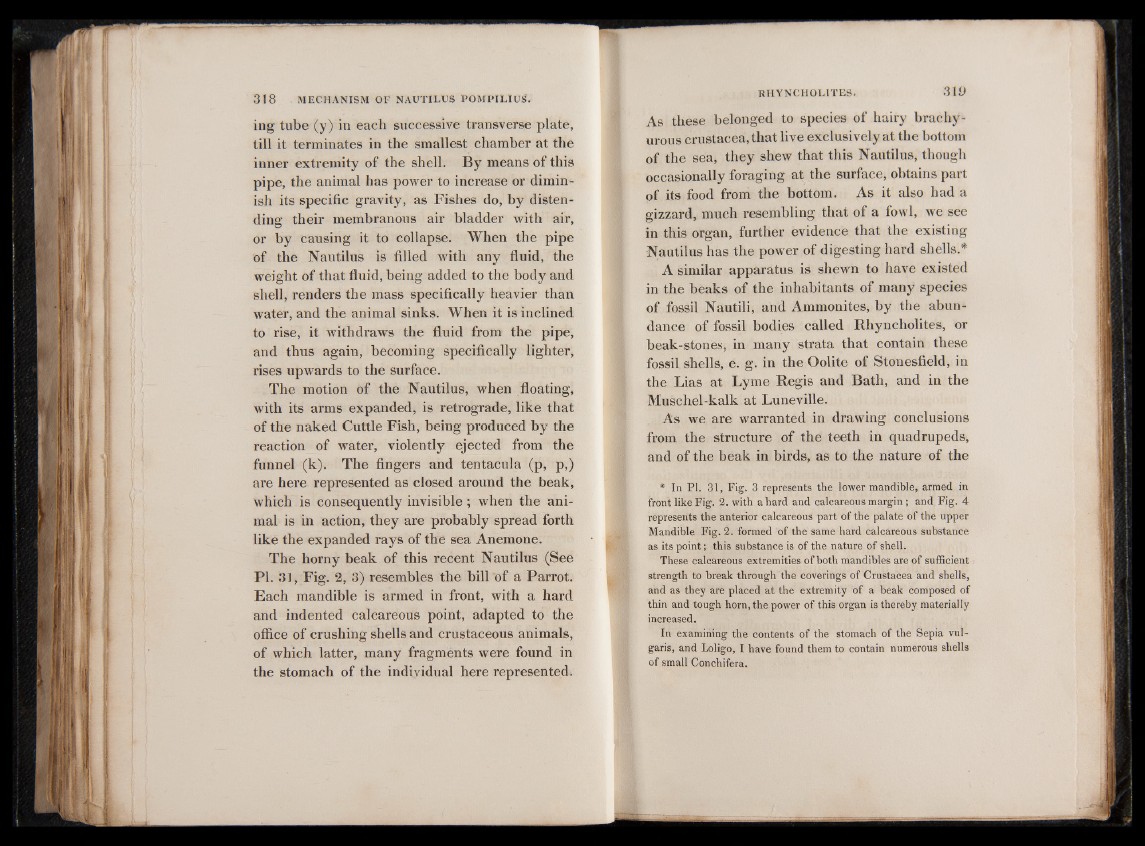
ing tube (y) in each successive transverse plate,
till it terminates in the smallest chamber at the
inner extremity of the shell. By means of this
pipe, the animal has power to increase or diminish
its specific gravity, as Fishes do, by distending
their membranous air bladder with air,
or by causing it to collapse. When the pipe
of the Nautilus is filled with any fluid, the
weight of that fluid, being added to the body and
shell, renders the mass specifically heavier than
water, and the animal sinks. When it is inclined
to rise, it withdraws the fluid from the pipe,
and thus again, becoming specifically lighter,
rises upwards to the surface.
The motion of the Nautilus, when floating,
with its arms expanded, is retrograde, like that
of the naked Cuttle Fish, being produced by the
reaction of water, violently ejected from the
funnel (k). The fingers and tentacula (p, p,)
are here represented as closed around the beak,
which is consequently invisible; when the animal
is in action, they are probably spread forth
like the expanded rays of the sea Anemone.
The horny beak of this recent Nautilus (See
PI. 31, Fig. 2 , 3) resembles the bill of a Parrot.
Each mandible is armed in front, with a hard
and indented calcareous point, adapted to the
office of crushing shells and crustaceous animals,
of which latter, many fragments were found in
the stomach of the individual here represented.
RHYNCHOL1TES. 31U
As these belonged to species of hairy brachy-
urous crustacea, that live exclusively at the bottom
of the sea, they shew that this Nautilus, though
occasionally foraging at the surface, obtains part
of its food from the bottom. As it also had a
gizzard, much resembling that of a fowl, we see
in this organ, further evidence that the existing
Nautilus has the power of digesting hard shells.*
A similar apparatus is shewn to have existed
in the beaks of the inhabitants of many species
of fossil Nautili, and Ammonites, by the abundance
of fossil bodies called Rhyncholites, or
beak-stones, in many strata that contain these
fossil shells, e. g. in the Oolite of Stonesfield, in
the Lias at Lyme Regis and Bath, and in the
Muschel-kalk at Luneville.
As we are warranted in drawing conclusions
from the structure of the teeth in quadrupeds,
and of the beak in birds, as to the nature of the
* In PI. 31, Fig. 3 represents the lower mandible, armed in
front like Fig. 2. with a hard and calcareous margin ; and Fig. 4
represents the anterior calcareous part of the palate of the upper
Mandible Fig. 2. formed of the same hard calcareous substance
as its point; this substance is of the nature of shell.
These calcareous extremities of both mandibles are of sufficient
strength to break through the coverings of Crustacea and shells,
and as they are placed at the extremity of a beak composed of
thin and tough horn, the power of this organ is thereby materially
increased.
In examining the contents of the stomach of the Sepia vulgaris,
and Loligo, I have found them to contain numerous shells
of small Conchifera.